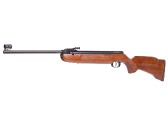In our continuing discussion of how modern airguns work, let’s take a look at one of the most popular, powerful, and easy-to-work power plants. To keep things easy, we will refer to all airguns operated by a metal spring or a gas ram as spring airguns. While a gas ram doesn’t look like a traditional metal coil spring, it is a “mechanical device that stores energy when compressed and returns to shape once released.”
Compressed On the Fly
Airguns operate by utilizing high-pressure air to propel a projectile down the barrel. PCP airguns, for instance, store high-pressure air in a cylinder for each shot. Multi-pump airguns require their cylinders to be refilled between each shot using an integrated pump, while CO2 airguns rely on compressed CO2 cylinders. In contrast, spring airguns operate in a distinct manner.
The storage chamber in a spring gun is called the compression chamber. It uses ambient air pressure that is compressed rapidly when a piston is driven forward by the spring. The pressure builds extremely quickly and eventually overcomes the resistance of the pellet in the breech to drive the pellet down the bore.
Unlike PCP, Muli-pump, and CO2 airguns, there’s no hammer or valve. The entire assembly is very simple and straightforward. If you want to see how this works in slow motion, take a look at a toy potato gun. The potato plugs the barrel, and when the handle is squeezed, the pressure builds up in the barrel until the potato is forced free.
The Shooting Cycle
Let’s walk through the entire shooting cycle. At rest, the compression chamber is not pressurized. Cocking the barrel engages the piston via the cocking linkage. For this explanation, we are working with a traditional break barrel but the principle is the same with any spring gun.
The linkage is connected to the piston, which houses the spring. At the end of the cocking stroke, the piston is locked in place with the trigger seer. At this point, the compression chamber is still unpressurized and is filled with air at ambient pressure.
When the shooter pulls the trigger, the piston is released. At the top of the piston is a parachute seal that expands against the compression chamber wall to form a tight seal as the piston is driven forward by the spring. All the air in the compression chamber is rapidly compressed. The heat and pressure are so intense that anything flammable, i.e., oil residue, cleaning solvent residue, etc., will ignite. This effect is called dieseling and is normal for the first few shots from a new high-powered spring gun as the remnants of the manufacturing process are burned off. This should rapidly subside with normal use, but if it doesn’t, contact the manufacturer and let them know.
As an important note, DO NOT introduce oils or other accelerants into the compression chamber on purpose, as you will damage your airgun. Several YouTube videos talk about how to “get more power” from your spring airgun. They may use WD40 or some other type of oil to force the gun to diesel. While it may work and sound impressive, it may also not work for very long, and the damage caused is not covered under the manufacturer’s warranty.
At the end of the shooting cycle, the piston slams into the front of the compression chamber. To fire again, simply cock the barrel, load your pellet, and repeat the process. There’s no cylinder to pump back up, air tank to fill, or CO2 to change. It’s a self-contained shooting machine that only requires some elbow grease and ammo.
Advantages and Disadvantages
When you look at the process and consider the power output vs user input, it would seem that spring airguns are the only way to go. While their performance is very impressive and they are very economical to purchase and operate, they have some serious drawbacks.
All airgun guns have some measure of recoil. Managing or eliminating recoil can make or break a gun’s ability to shoot accurately. Spring guns make matters worse as they can recoil in three different directions during the shooting cycle. All while the pellet is still in the barrel. This can cause the barrel position to vary from shot to shot, making it seem that spring airguns are inherently inaccurate.
A traditional coiled metal spring will recoil in three different directions. The first is rearward as the gun is fired, and the spring accelerates the piston through the compression chamber. The second is rotational, opposite the direction of the spring as it uncoils. The third is forward when the heavy metal piston hits the front of the compression chamber. Utilizing a gas ram will eliminate the rotational recoil, but it will still have rearward and forward recoil.
Manufacturers have spent much time and energy trying to create ways of lessening or eliminating the recoil from a spring gun. Ultimately, it will come down to your technique as the best way to overcome this major disadvantage. The common technique is called the artillery hold which is a means of holding and shooting a spring gun, not to prevent it from moving during the shooting cycle, but rather creating a highly repeatable movement so that your POI remains as consistent as possible.
Are Spring Guns Worth It?
Spring guns have some amazing advantages, and while they can be a challenge to learn to shoot, the result is worth the effort. Nearly all the techniques needed to shoot spring guns accurately directly transfer to all other shooting disciplines. They produce much power for minimal effort and require no extra “stuff” to make them work. If you have more questions or want to know what type of spring gun would be best for your needs, please call us. We are always here to help.
